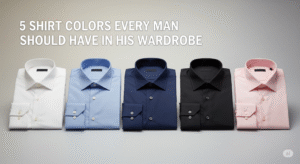The Ultimate Guide to Choosing the Perfect Shirt Fit
When it comes to shirts, style is important – but fit is everything. You could be wearing the most expensive designer shirt, yet if it doesn’t fit right, it won’t look good. The perfect shirt fit is the secret to looking sharp, confident, and well-dressed for any occasion.
But here’s the challenge: not every shirt is made for every body type, and not all fits are the same. In this guide, we’ll break down everything you need to know about choosing the perfect shirt fit, from understanding different fit types to measuring yourself correctly and styling your shirt for different occasions.
1. Why Shirt Fit Matters
A good fit isn’t just about comfort – it’s about style, proportion, and how you carry yourself.
-
Boosts Confidence: A well-fitted shirt enhances your physique and makes you feel good.
-
Looks Professional: Whether for business meetings or social events, a sharp fit makes a lasting impression.
-
Enhances Comfort: The right fit allows easy movement without feeling too tight or too loose.
Remember: The goal is for your shirt to look tailored to you, even if it’s off the rack.
2. The Different Types of Shirt Fits
Shirt fits are generally categorized into three main styles. Knowing these will help you choose according to your body type and purpose.
A. Slim Fit
-
Description: Narrower at the chest and waist, hugging the body without being skin-tight.
-
Best For: Lean or athletic body types.
-
Occasions: Office wear, date nights, casual outings.
-
Styling Tip: Pair with slim-fit trousers or jeans to keep proportions balanced.
B. Regular Fit
-
Description: A classic cut with room in the chest and waist for comfort.
-
Best For: Most body types, especially those who prefer a relaxed feel.
-
Occasions: Daily office wear, semi-formal events, casual gatherings.
-
Styling Tip: Tuck into trousers for a formal look or leave untucked for a casual vibe.
C. Relaxed / Loose Fit
-
Description: Generous cut providing maximum comfort and airflow.
-
Best For: Larger body types or those who want a laid-back style.
-
Occasions: Casual, beach wear, travel.
-
Styling Tip: Works best with shorts, chinos, or relaxed jeans.
3. How to Measure Yourself for the Perfect Shirt Fit
Before buying a shirt, especially online, it’s crucial to know your exact measurements. Here’s what you need:
-
Neck: Wrap the measuring tape around the base of your neck, leaving a finger’s width for comfort.
-
Chest: Measure around the fullest part of your chest with the tape snug but not tight.
-
Waist: Measure around your natural waistline, typically just above the hips.
-
Sleeve Length: Start from the back of your neck, over your shoulder, down to your wrist.
-
Shoulder Width: Measure from the tip of one shoulder to the other.
Pro Tip: Always measure yourself in front of a mirror or get someone to help for accuracy.
4. Signs Your Shirt Fits Perfectly
You know your shirt fits well when:
-
The shoulder seams align exactly with your shoulders.
-
The collar sits comfortably without feeling tight or gaping.
-
You can slide two fingers between your neck and the collar.
-
The sleeves reach your wrist bone without pulling when you bend your arms.
-
The shirt stays tucked in without bunching up (for formal wear).
5. Common Shirt Fit Mistakes to Avoid
-
Too Tight Around the Buttons: If buttons are pulling, the shirt is too small.
-
Excess Fabric Around the Waist: Indicates the shirt is too large for your frame.
-
Oversized Sleeves: Makes your arms look shorter and less defined.
-
Collar Gaping or Choking: Wrong neck measurement.
6. Choosing the Right Fit for Your Body Type
-
Tall & Slim: Slim-fit shirts enhance shape but avoid overly tight fits.
-
Athletic Build: Tailored fits work best to highlight the shoulders and chest.
-
Broad or Plus Size: Regular or relaxed fits provide comfort and balance.
-
Shorter Height: Slim or tailored fits prevent a bulky look.
7. Fabric & Fit – The Connection
Even with the right size, fabric can affect the fit:
-
Cotton: Soft, breathable, and slightly structured – works well for formal and casual shirts.
-
Linen: Lightweight with a relaxed drape – ideal for summer.
-
Polyester Blends: Stretchy and wrinkle-resistant – great for everyday wear.
8. How to Style Each Fit
Slim Fit Styling:
-
Works best tucked in with a belt for formal events.
-
Layer with a blazer or jacket for a sharp look.
Regular Fit Styling:
-
Versatile – tuck for office, untuck for weekends.
-
Works with jeans, chinos, or trousers.
Relaxed Fit Styling:
-
Keep it casual with shorts or joggers.
-
Roll up sleeves for a beach or holiday vibe.
9. Final Checklist Before Buying a Shirt
-
Does it fit well at the shoulders?
-
Is there enough room to move comfortably?
-
Does the collar feel just right?
-
Are the sleeves the correct length?
-
Does it match the occasion you’re buying it for?
Final Thoughts
The perfect shirt fit is the balance between style and comfort. Understanding different fits, knowing your measurements, and choosing the right cut for your body type can transform how you look and feel in a shirt.
Whether it’s slim, regular, or relaxed fit, your shirt should feel like it was made just for you. And if you’re ready to find your ideal fit, check out our latest shirt collection here – because the right fit isn’t just a choice, it’s a lifestyle.




